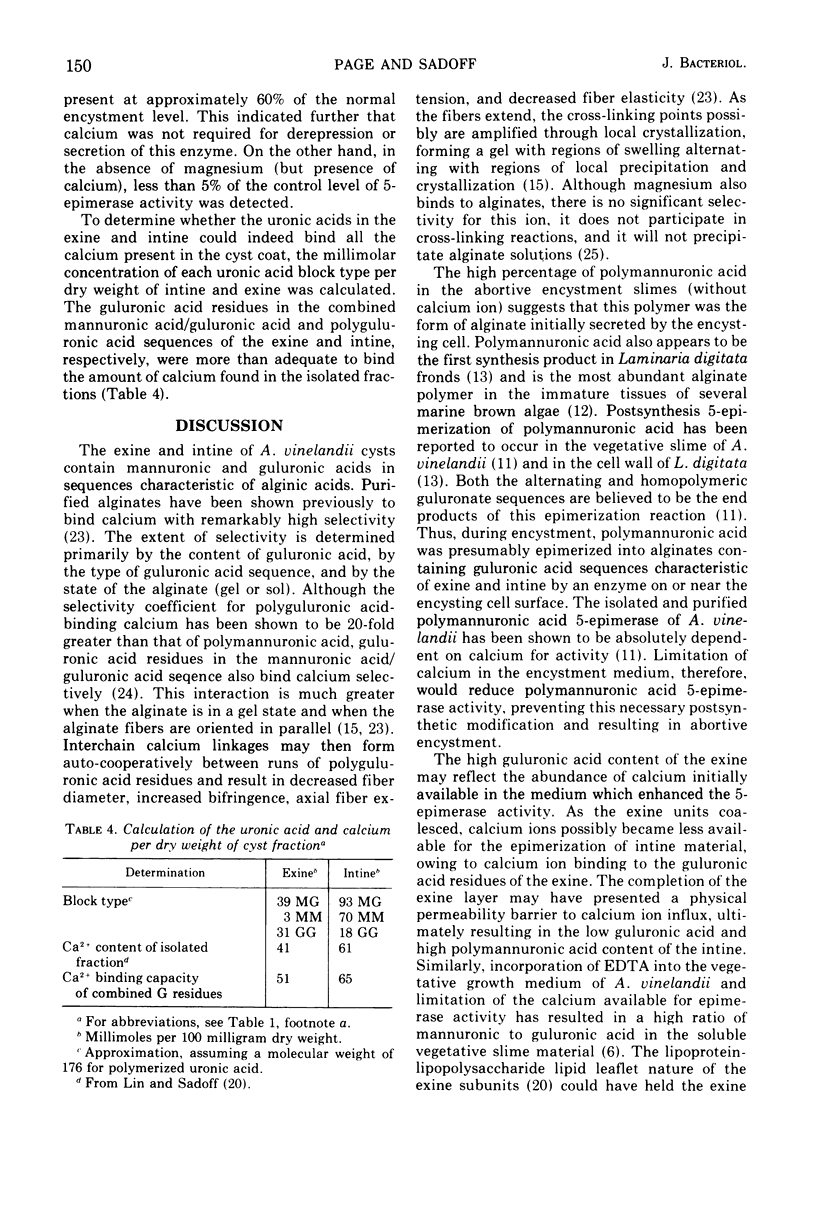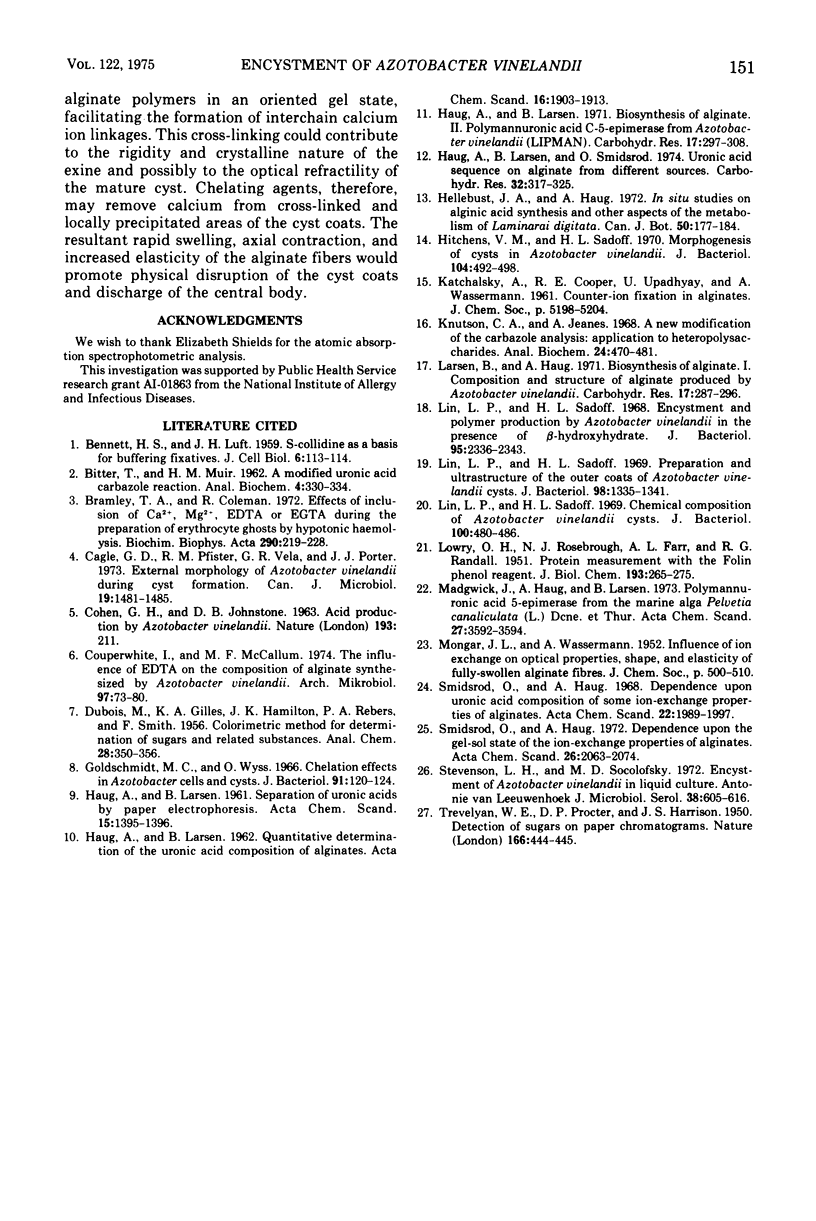Abstract
Encystment of Azotobacter vinelandii (ATCC 12837) in modified Burk nitrogen-free medium (pH 7.0) containing 0.2 percent beta-hydroxybutyrate occurs optimally in 0.37 to 0.44 mM solutions of calcium ions. Suspension of cells in media deficient in calcium results in abortive encystment characterized by the release of viscous cyst coat material. Mature cysts rupture in ethylene glycol-bis-(beta-aminoethyl ether)-N,N'-tetraacetic acid, suggesting that calcium is a structural component of the cyst coat. Maximal stimulation of encystment by calcium ions occurs prior to the completion of the cyst exine or outer coat. The uronic acid composition of cyst components is dependent on calcium levels in the medium. Uronic acids account for 31.7 percent of the intine (inner coat) and 13 percent of the exine dry weight, and only mannuronic and guluronic acids are present in these fractions. These can be extracted as homo- and heteropolymeric sequence "blocks" characteristic of alginic acids. The polyuronic acid fraction of both the cyst coats contain approximately equal amounts of heteropolymeric (mannuronic acid/guluronic acid) blocks. The exine, however, is richer in polyguluronic acid and the intine is richer in polymannuronic acid. As a result, the mannuronic acid/guluronic acid ratio of the exine is lower than that of the intine. Slimes that form in abortive encystment are rich in polymannuronic acid and have a high mannuronic acid/guluronic acid ratio. A polymannuronic acid 5-epimerase is active in the mature cyst central body and the encystment culture fluid.
Full text
PDF






Selected References
These references are in PubMed. This may not be the complete list of references from this article.
- BENNETT H. S., LUFT J. H. zeta-Collidine as a basis for buffering fixatives. J Biophys Biochem Cytol. 1959 Aug;6(1):113–114. doi: 10.1083/jcb.6.1.113. [DOI] [PMC free article] [PubMed] [Google Scholar]
- BITTER T., MUIR H. M. A modified uronic acid carbazole reaction. Anal Biochem. 1962 Oct;4:330–334. doi: 10.1016/0003-2697(62)90095-7. [DOI] [PubMed] [Google Scholar]
- Bramley T. A., Coleman R. Effects of inclusion of Ca 2+ , Mg 2+ , EDTA or EGTA during the preparation of erythrocyte ghosts by hypotonic haemolysis. Biochim Biophys Acta. 1972 Dec 1;290(1):219–228. doi: 10.1016/0005-2736(72)90065-x. [DOI] [PubMed] [Google Scholar]
- COHEN G. H., JOHNSTONE D. B. Acid production by Azotobacter vinelandii. Nature. 1963 Apr 13;198:211–211. doi: 10.1038/198211a0. [DOI] [PubMed] [Google Scholar]
- Cagle G. D., Pfister R. M., Vela G. R., Porter J. J. External morphology of Azotobacter vinelandii during cyst formation. Can J Microbiol. 1973 Dec;19(12):1481–1485. doi: 10.1139/m73-241. [DOI] [PubMed] [Google Scholar]
- Couperwhite I., McCallum M. F. The influence of EDTA on the composition of alginate synthesized by Azotobacter vinelandii. Arch Mikrobiol. 1974 Apr 10;97(1):73–80. doi: 10.1007/BF00403047. [DOI] [PubMed] [Google Scholar]
- Goldschmidt M. C., Wyss O. Chelation effects on Azotobacter cells and cysts. J Bacteriol. 1966 Jan;91(1):120–124. doi: 10.1128/jb.91.1.120-124.1966. [DOI] [PMC free article] [PubMed] [Google Scholar]
- Haug A., Larsen B. Biosynthesis of alginate. II. Polymannuronic acid C-5-epimerase from Azotobacter vinelandii (Lipman). Carbohydr Res. 1971 Apr;17(2):297–308. doi: 10.1016/s0008-6215(00)82537-9. [DOI] [PubMed] [Google Scholar]
- Hitchins V. M., Sadoff H. L. Morphogenesis of cysts in Azotobacter vinelandii. J Bacteriol. 1970 Oct;104(1):492–498. doi: 10.1128/jb.104.1.492-498.1970. [DOI] [PMC free article] [PubMed] [Google Scholar]
- Knutson C. A., Jeanes A. A new modification of the carbazole analysis: application to heteropolysaccharides. Anal Biochem. 1968 Sep;24(3):470–481. doi: 10.1016/0003-2697(68)90154-1. [DOI] [PubMed] [Google Scholar]
- LOWRY O. H., ROSEBROUGH N. J., FARR A. L., RANDALL R. J. Protein measurement with the Folin phenol reagent. J Biol Chem. 1951 Nov;193(1):265–275. [PubMed] [Google Scholar]
- Larsen B., Haug A. Biosynthesis of alginate. 1. Composition and structure of alginate produced by Azotobacter vinelandii (Lipman). Carbohydr Res. 1971 Apr;17(2):287–296. doi: 10.1016/s0008-6215(00)82536-7. [DOI] [PubMed] [Google Scholar]
- Lin L. P., Sadoff H. L. Chemical composition of Azotobacter vinelandii cysts. J Bacteriol. 1969 Oct;100(1):480–486. doi: 10.1128/jb.100.1.480-486.1969. [DOI] [PMC free article] [PubMed] [Google Scholar]
- Lin L. P., Sadoff H. L. Encystment and polymer production by Azotobacter vinelandii in the presence of beta-hydroxybutyrate. J Bacteriol. 1968 Jun;95(6):2336–2343. doi: 10.1128/jb.95.6.2336-2343.1968. [DOI] [PMC free article] [PubMed] [Google Scholar]
- Lin L. P., Sadoff H. L. Preparation and ultrastructure of the outer coats of Azotobacter vinelandii cysts. J Bacteriol. 1969 Jun;98(3):1335–1341. doi: 10.1128/jb.98.3.1335-1341.1969. [DOI] [PMC free article] [PubMed] [Google Scholar]
- Madgwick J., Haug A., Larsen B. Polymannuronic acid 5-epimerase from the marine alga Pelvetia canaliculata (L.) Dcne. et Thur. Acta Chem Scand. 1973;27(9):3592–3594. doi: 10.3891/acta.chem.scand.27-3592. [DOI] [PubMed] [Google Scholar]
- Smidsrod O., Haug A. Dependence upon the gel-sol state of the ion-exchange properties of alginates. Acta Chem Scand. 1972;26(5):2063–2074. doi: 10.3891/acta.chem.scand.26-2063. [DOI] [PubMed] [Google Scholar]
- TREVELYAN W. E., PROCTER D. P., HARRISON J. S. Detection of sugars on paper chromatograms. Nature. 1950 Sep 9;166(4219):444–445. doi: 10.1038/166444b0. [DOI] [PubMed] [Google Scholar]


